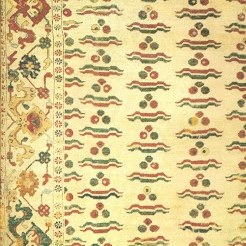It was given the name Cintamani because some scholars have tried to link the design with the three stones of Buddha, since the Ottoman Empire had strong trading links with the East and it would make some sense to assume that the rug weavers of old might have found the symbol appealing. So popular was this design that it was used in the garments of the elite and the Royal courts of the Ottoman Empire. Many Cintamani carpets were commissioned by the Sultans and the rule of thumb is that if the three circles were placed on top of the wavy lines, it was a Royal Ottoman carpet. If the three circles were placed under the wavy lines it was a normal Anatolian carpet. Naturally the Royal commissions had a higher value.
The three circles grouped in a triangle is indeed a very sacred symbol in Buddhism. According to legend the “mani stone” is one of four relics that came in a chest that fell from the sky during the reign of king Lha Thothori Nyantsen of Tibet. Though the king did not understand the purpose of the objects, he kept them in a position of reverence. Several years later, two mysterious strangers appeared at the court of the king, explaining the four relics, which included the Buddha's bowl (possibly a Singing Bowl) and a mani stone with the Om Mani Padme Hum mantra inscribed on it. These few objects were the bringers of the Dharma to Tibet. The Buddhist trinity consist of Buddha, Dharma and Shangha and these three states are represented by the three circles grouped in a triangle.
We find legends of three sacred treasures in many civilizations, believed to be given by the gods or representing the gods. The Three Sacred Treasures of Japan for instance, consist of the sword Kusanagi, the mirror Yata no Kagami and the jewel Yasakani no Magatama. The regalia represent the three primary virtues: valor (the sword), wisdom (the mirror), and benevolence (the jewel). It is believed that the Emperor was chosen by god and given these three treasures to safeguard him and ensure his success as ruler. What is interesting here is that the Egyptian hieroglyphic symbol for the star, Sirius, closely resembles these three objects, being an obelisk (sword), a half circle (mirror) and a star (jewel). Sirius is the brightest star in our night sky and it disappears every year for seventy days, but reappears just before the summer solstice and annual flooding of the Nile. Due to this occurrence, Sirius’s appearance was very important to the Ancient Egyptians who worshipped Sirius as the goddess Sopdet, the goddess of fertility.
The sacred or holy trinity is no stranger in the world. From the holy trinity in the Semitic religions to the three physical stages of life (represented by the spiral of life that looks quite similar to the cintamani), the body, mind and soul concepts, the mother, father, child trinity and even the electron, neutron and proton trinity. It is quite interesting that Memling, a German painter in the 15th century, painted Christ with a cintamani amulet around his neck. But the cintamani was also used in art in other civilizations in the world. The Etruscans, Romans, Greeks and even Mesoamericans used the cintamani design to decorate their textiles, arts, pottery, etc. centuries BC.
The cintamani seems to have been a universal symbol used by everyone and was again made popular in 1935 by Nicholas Roerich who proposed the symbol for the banner of peace that was accepted as an international pact for the protection of culture values. The Banner proposed had on the white background three united amaranth spheres as a symbol of Eternity and Unity that very closely resembles the cintamani. On further investigation, the Amaranth seeds was of utmost importance to the Mesoamericans as their staple food and source of energy. Another important use of amaranth throughout Mesoamerica was to prepare ritual drinks and foods. To this day, amaranth grains are toasted much like popcorn and mixed with honey, molasses, or chocolate to make a treat called alegría, meaning "joy" in Spanish. Because of its importance as a symbol of indigenous culture, its gluten-free palatability, ease of cooking, and a protein that is particularly well-suited to human nutritional needs, interest in grain amaranth revived in the 1970s. The seeds, leaves, stems and roots of the Amaranth is edible and even the flowers were used as a red dye by the Hopi Indians. From antiquity the amaranth plant was linked to immortality because it is an unwilting plant. In ancient Greece, the amaranth was sacred to Ephesian Artemis. It allegedly had special healing properties, and, as a symbol of immortality, was used to decorate images of the gods and tombs. The Chinese used amaranth widely for its healing chemicals, treating illnesses such as infections, rashes, and migraines. There is even some talk that it grew in the Garden of Eden next to the Tree of Life. And so the list of its fame and uses goes on.
Whether the cintamani is an ancient religious symbol or linked to the immortal amaranth we will never know for sure, since there is not a lot of information available on the creation of the symbol. It has somehow captured our imagination through the ages and has almost a calming effect, with three being a holy number. It certainly makes for very attractive carpets and textiles.
References:
- https://en.wikipedia.org/wiki/Sirius#Serer_religion
- https://en.wikipedia.org/wiki/Amaranth
- https://awitchylife.wordpress.com/…/the-meaning-of-the-spi…/
- https://en.wikipedia.org/wiki/Turkish_carpet
- https://en.wikipedia.org/wiki/Cintamani
- https://en.wikipedia.org/wiki/Banner_of_Peace
- https://en.wikipedia.org/wiki/Dharma
- https://en.wikipedia.org/wiki/Imperial_Regalia_of_Japan
- https://en.wikipedia.org/wiki/Hans_Memling
- https://en.wikipedia.org/wiki/Banner_of_Peace
- http://www.green-man-of-cercles.org/articles/cintamani.pdf



